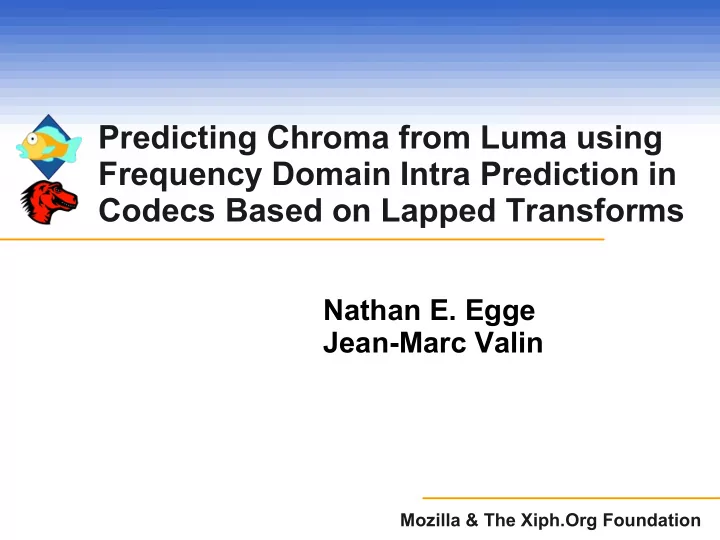

Predicting Chroma from Luma using Frequency Domain Intra Prediction in Codecs Based on Lapped Transforms Nathan E. Egge Jean-Marc Valin Mozilla & The Xiph.Org Foundation
Intra-Prediction of Chroma ● In 4:2:0 image data, chroma is 50% of luma ● Chroma predicted spatially by signalling a directional mode – Reconstructed neighbors must be available to decode a block – Limited to predicting from current color plane ● Cross-channel correlation not exploited ● Does not work with codecs using lapped transforms Mozilla & The Xiph.Org Foundation
Spatial Domain Intra-Prediction The intra-prediction modes for 4x4 blocks in WebM (VP8). Mozilla & The Xiph.Org Foundation
Lapped Transforms Mozilla & The Xiph.Org Foundation
Decoding an Intra Frame with Lapped Transforms Neighboring blocks: Reconstructed Image Predicted Unpredicted Currently Predicting Needs Post-filter Prediction Support Mozilla & The Xiph.Org Foundation
Predicting Chroma from Luma ● Key insight: YUV conversion de-correlates luma and chroma globally, but local relationship exists [1] ● Both encoder and decoder compute linear regression: ● Use reconstructed luma coefficients to predict coincident chroma coefficients: [1] S.H. Lee & N.I. Cho: “Intra prediction method based on the linear relationship between the channels for YUV 4 2 0 ∶ ∶ Not selected for HEVC due to ● intra coding” ICIP 2009, pp. 1033-1036 20-30% increased complexity Mozilla & The Xiph.Org Foundation
Adapting Chroma from Luma to the Frequency Domain ● Key insight: LT and DCT are both linear transforms so similar relationship exists in frequency domain ● Both encoder and decoder compute linear regression using 4 LF coefficients from Up, Left and Up-Left ● Use reconstructed luma coefficients to predict coincident chroma coefficients: Block Size SD-CfL FD-CfL Adds Mults Adds Mults Still expensive, but cost ● N x N 4*N+2 8*N+3 2*12+5 4*12+5 constant with block size 4 x 4 18 35 29 53 8 x 8 34 67 29 53 Mozilla & The Xiph.Org Foundation 16 x 16 66 131 29 53
Example Original uncompressed image Mozilla & The Xiph.Org Foundation
Example Reconstructed luma with predicted chroma using FD-CfL Mozilla & The Xiph.Org Foundation
Frequency Domain CfL ● Adapted CfL algorithm to the frequency domain – No signalling overhead ● Implicitly defined model parameters ( , , ) ● Increased decoder complexity – Model parameters could be signalled for use cases – Works with existing LT based codecs using scalar quantization Mozilla & The Xiph.Org Foundation
Perceptual Vector Quantization ● Separate “gain” (contrast) from “shape” (spectrum) – Vector = Magnitude × Unit Vector (point on sphere) ● Given prediction vector – “gain” predicted by magnitude – “shape” predicted using Householder reflection Mozilla & The Xiph.Org Foundation
Shape Prediction Example ● Input + Prediction Prediction Input 12 Mozilla & The Xiph.Org Foundation
Shape Prediction Example ● Input + Prediction ● Compute Householder Reflection ● Apply Reflection ● Compute & Prediction θ code angle ● Code other Input dimensions 13 Mozilla & The Xiph.Org Foundation
PVQ Prediction with CfL ● Consider prediction of 15 AC coefficients of 4x4 Cb ● The 15-dimensional predictor is scalar multiple of coincident reconstructed luma coefficients ● Thus “shape” predictor is almost exactly ● Only difference is direction of correlation! 14 Mozilla & The Xiph.Org Foundation
PVQ Chroma from Luma 1: Let = , compute θ 2: If θ = 0 prediction is exact, code θ 3: Else 4: Code a flip flag, f = θ > 90 ° 5: If f , let = - 6: Code with PVQ using predictor 7: End 15 Mozilla & The Xiph.Org Foundation
Still Image Experiment ● Sample of 50 high resolution still images taken from Wikipedia down-sampled to 1 megapixel ● Comparison of No-CfL, FD-CfL and PVQ-CfL – Encode with 28 different quantization levels – Compute rate/distortion on Cb and Cr planes using four metrics: PSNR, PSNR-HVS, SSIM, FastSSIM – Hold all other techniques constant Mozilla & The Xiph.Org Foundation
Still Image Experiment Mozilla & The Xiph.Org Foundation
Still Image Experiment Cont. Computation of the Bjontegaard distance (improvement) between two rate-distortion curves Metric Cb (plane 1) Cr (plane 2) ∆ Rate (%) ∆ SNR (dB) ∆ Rate (%) ∆ SNR (dB) PSNR -1.87644 0.07678 -0.90748 0.04650 PSNR-HVS -2.57971 0.13205 -1.08077 0.06460 SSIM -3.09834 0.08842 -1.81715 0.06315 FastSSIM -3.01455 0.06602 -1.81869 0.04385 Improvement moving from No-CfL to FD-CfL Metric Cb (plane 1) Cr (plane 2) ∆ Rate (%) ∆ SNR (dB) ∆ Rate (%) ∆ SNR (dB) PSNR -3.13262 0.12853 -1.47899 0.07590 PSNR-HVS -5.19186 0.26913 -2.31499 0.13921 SSIM -5.54403 0.15962 -3.45484 0.12093 FastSSIM -6.10963 0.13577 -4.59056 0.11116 Improvement moving from No-CfL to PVQ-CfL Mozilla & The Xiph.Org Foundation
Conclusions & Future Work ● Introduced 2 algorithms for Chroma-from-Luma intra prediction in codecs using LT – FD-CfL suitable for use with scalar quantization – PVQ-CfL extends gain-shape quantization ● No additional per block complexity ● Improved performance (both rate and quality) ● Can we use both reconstructed Luma and Cb with PVQ to predict Cr? Mozilla & The Xiph.Org Foundation
Resources ● Daala codec website: https://xiph.org/daala/ ● Daala Technology Demos: https://people.xiph.org/~xiphmont/demo/daala/ ● Git repository: https://git.xiph.org/ ● IRC: #daala channel on irc.freenode.net ● Mailing list: daala@xiph.org 20 Mozilla & The Xiph.Org Foundation
Questions? Mozilla & The Xiph.Org Foundation
Recommend
More recommend